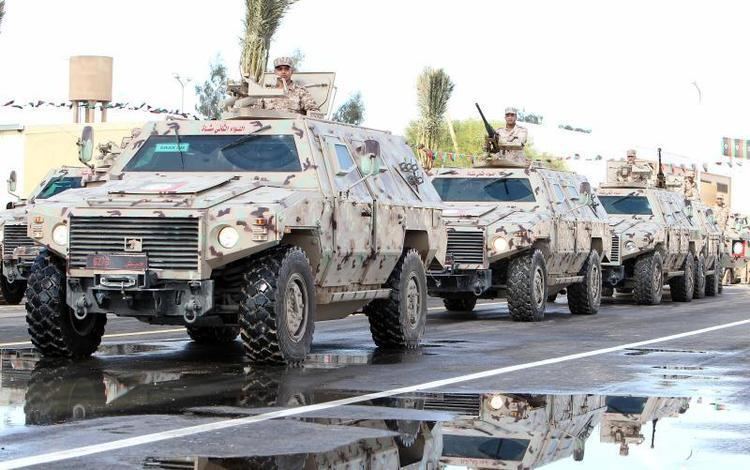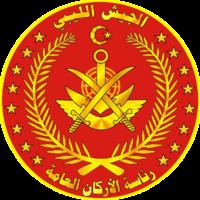Founded 1951–1969 Allies Zintan Brigades, Al-Saiqa | Current form 2011 | |
Available formilitary service 1,775,078 males, age 15–49,1,714,194 females, age 15–49 Fit formilitary service 1,511,144 males, age 15–49,1,458,934 females, age 15–49 Similar Libyan Air Force, Libyan Army, Free Libyan Air Force, Chad National Army, Tunisian Armed Forces | ||
The Libyan National Army is the national armed force of Libya, comprising the ground army, the air force and the navy. It was established by the Libyan government after the first Libyan civil war, as Libya's previous national army was defeated by the uprising and disbanded.
Contents
- Structure of the National Army
- Ground Forces
- History
- Equipment
- Technicals
- Tanks
- Armoured personnel carriers
- Artillery
- Helicopters
- References
In the ongoing Second Libyan Civil War, the Libyan National Army is loyal to the internationally recognized government in Tobruk. It therefore fights against the Islamist Libya Dawn, the Shura Council of Benghazi Revolutionaries and the Islamic State in Libya.
At the beginning of the Second Libyan Civil War, the army was split between Khalifa Haftar's "anti-terrorist" faction, which acted largely independently, and Abdulsalam al-Obaidi's "legalist" faction which relied on orders from political authorities. In 2014, the Council of Deputies appointed Khalifa Haftar commander of the whole army, re-uniting the two factions. Abdulrazek Al Nadoori is chief of staff.

In the case of the many armed groups in Libya, they do not belong to the Libyan National Army unless they pledge allegiance to it. Many armed groups that exist in areas outside the control of the Council of Deputies and the Libyan National Army accept government funding and openly exert authority associated with official forces, while not have a commitment to obey the Libyan National Army hierarchy or the government. As the Second Libyan Civil War progresses, armed groups are increasingly condemned by the Council of Deputies and have been branded illegal.

Structure of the National Army
Ground Forces
Formations include:
History

The Libyan National Army was founded in 2011 by the National Transitional Council, after forces aligned to it defeated the previous Libyan Army and overthrew Muammar Gaddafi's regime. Supply depots and bases having been damaged during the civil war, the new army is faced with the challenge of having to rebuild much of the country's military infrastructure. Yousef Mangoush was named as its first Chief of Staff on 2 January 2012 and the force saw its first major deployment on 23 February, when it was deployed to Kufra to intervene in a tribal conflict.

In November 2011, the National Transitional Council begun the difficult process of restructuring the army, with military personnel who defected from the Gaddafi regime and former rebel fighters of the National Liberation Army forming the basis of the new Libyan Army. Major General Khalifa Belgacem Haftar was chosen as the overall commander of the new Libyan Army due to his military experience and loyalty to the revolution that overthrew Gaddafi.
The Libyan Army only numbered "a few thousand" trained soldiers in November 2011, and was rapidly trying to train up new fighters who could keep the peace nationwide and deter rogue militias from acting without NTC orders, and was responsible for brokering a ceasefire on at least one occasion in November between warring militas from Zawiya and Al Maya.
On 1 December 2011, it was reported that the National Liberation Army was to integrate up to 50,000 former rebel fighters into the new Libyan national army and police forces, with the aid of French training, with long term aims to integrate as many as 200,000 fighters from the brigades that had fought against Gaddafi during the civil war.
In December 2011, Italy agreed to provide training the Libyan Army as it attempted to reorganize in the aftermath of the civil war.
Also in December, large numbers of former rebels were being given jobs in the new army, whilst the government also announced that they would be free to join the special forces and the navy too. According to Osama al-Juwaili, the defence minister: "The idea is to inject new blood in the army which was marginalised by the tyrant (Gaddafi)"
General Yousef Mangoush said on 5 January 2012 that Libya's new army faces major obstacles such as rebuilding bases destroyed during the conflict, as well as disarming militias that were not part of the new army. National Army commander General Khalifa Haftar said later that it could take between three and five years for Libya to field a capable enough army to protect its borders.
On 7 May 2013, Libya’s Defense Minister Mohammed al-Barghathi resigned on Tuesday due to a crisis caused by gunmen who have besieged two ministries for more than a week, a ministry official said. He later withdrew his resignation after Prime Minister Zeidan convinced him to stay.
Under an agreement reached at the Lough Erne G8 summit in June 2013, NATO countries the United Kingdom, Italy, Turkey, and the United States undertook to help train up to 15,000 personnel from Libyan National Army units over a two-year period. They were to take units from newly formed brigades for 10-week stints of intensive infantry training. The 27th Brigade was due to start at Bassingbourn in eastern England in January 2014. As a result of disorder and sexual assaults by some Libyan army cadets, the UK cancelled the programme in November 2014. The Libyan trainees were sent back to Libya, with the exception of five who were tried for sexual offenses.
Al-Saiqa is an elite army unit, formed from a mixture of paratroopers and commandos. It numbers a few thousand and reports to the Ministry of Defence. It is popular in Benghazi, particularly in light of its opposition to Islamist Ansar al-Sharia group and because it is seen as a symbol of the reborn Libyan armed forces.
Equipment
Whilst it is known to a degree what equipment the Libyan army uses, the exact numbers of the below equipment currently in use is not known.
Technicals
A variety of pickup/utility vehicles, called technicals and gun trucks, often Toyota and other makes, armed with a variety of different weapons, including heavy machineguns, grad rockets and anti aircraft guns.
